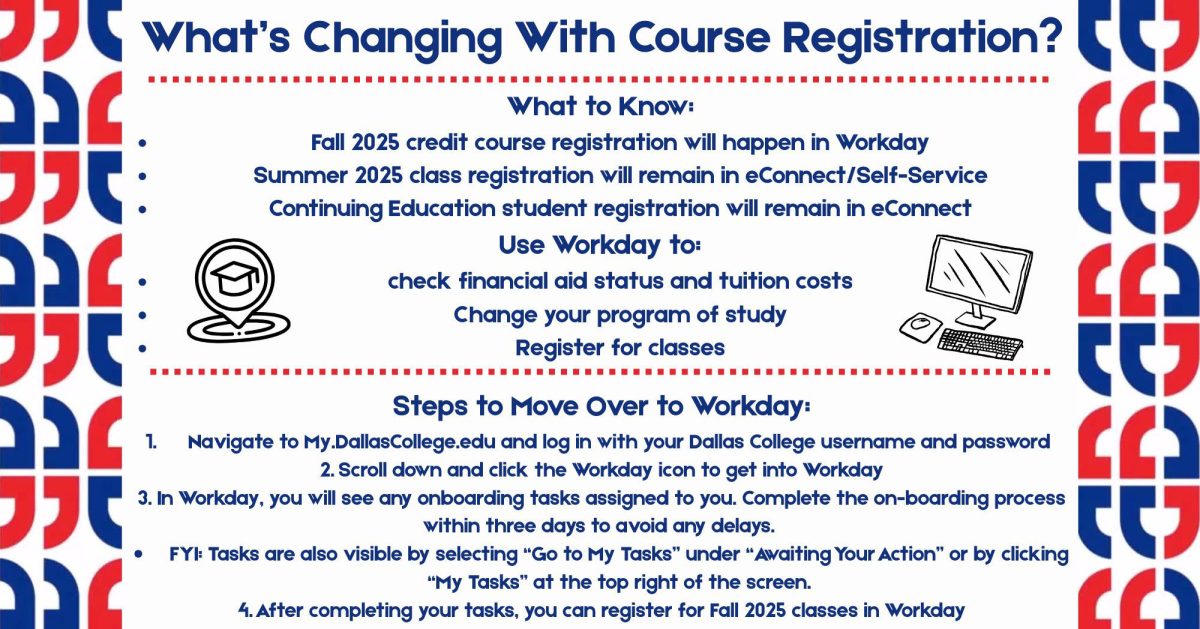The new Guided Pathways will help students plan their education and stay on track to graduate, transfer, or work.
By Jubenal Aguilar & Victoria Valdez
Editor-in-Chief & Sports Editor

The Dallas County Community College District launched Guided Pathways to Success, a tool to help students select the most appropriate courses for their degree plan or career.
The program, which is still in development, was created to redesign the student experience, set academic goals based on career or transfer interests, develop a plan to reach those goals and keep students on track in college, according to the DCCCD website.
“The pathways by themselves will show students what courses are needed for completion of the career path chosen,” Brenda Dalton, senior executive dean of student and enrollment services, said in an email to The Courier.
As of April 3, there were approximately 48 guided pathways, according to the DCCCD website. These are divided into seven career paths.
New pathways are continuously being developed by staff and faculty. Dalton said about 100 guided pathways will be mapped out in the 2018-2019 academic year. “All the programs will eventually be mapped as guided pathways,” Dalton said.
Dalton said students should find their guided pathway to complete their goals. “Every student should have a goal, so finding a map to follow to meet even one small goal is advantageous,” she said.
Dalton said Guided Pathways is meant to benefit new students, but it can benefit continuing education students who have completed numerous credit hours toward their educational or vocational goals.
Guided Pathways also helps students smoothly transition to a four-year school. “I believe Guided Pathways is a great tool to help students choose their path and alleviate taking courses that will not transfer or help them graduate,” Georgia Alvarez, senior administrative assistant to the vice president of academic affairs, said.
Students will receive a guided pathway after choosing their career path and contacting a pathways adviser.
A network of individuals will serve as students’ support systems in their paths. These will include guided pathways advisers, career coaches and DCCCD navigators.
A student’s career coach and pathways adviser will help unitl the student completes their certificate or degree, transfer to a four-year school or enter the job market, according to the DCCCD website.
DCCCD navigators will be available for one-on-one assistance to help students balance work, family and school by connecting them to helpful resources within their college and community.
Sharon Jackson, mathematics professor, said school academic advisers and instructors also benefit from Guided Pathways. “It helps us as instructors when we know what path a student is on,” Jackson said. “It helps advisers help students the best.”
“When I was a student, I wished I had something like this,” Jackson, said. She said having something like Guided Pathways would have helped her find her career path quicker.
Jackson said she likes that the program will provide career coaching. “I like how it narrows down the choices of careers by meta-majors because sometimes students come [to college] and they are not sure what they want to do,” Jackson said. “They may know the area they want to study, but not the specific area.”
Guided Pathways will be available in one-page, printable, mobile-friendly PDFs, according to the DCCCD website.
Each document will list the catalog year, guided pathway description, career path icon and which colleges offer the guided pathway. A course listing with a semester-by-semester map will show which specific courses should be taken each semester.
To the left of the course listings, students will see a column with designated labels, such as C or D, indicating if a course is required to earn a certificate or degree, respectively.
To the right, an action items checklist will show students which key milestones should be completed to stay on track for completing the guided pathway.
A degree plan shows students all the different classes they can pick from to complete their chosen certificate or degree, according to the DCCCD website. A guided pathway has more specific items suggested for students. Students do not have to make as many decisions about what to select.
In 2016, district employees collaborated to develop career paths after gathering feedback from students in a semester-long research study. Students shared their experiences with admissions, advising, financial aid and other services. After discovering students had trouble navigating through college, Guided Pathways was created by faculty and staff, according to the DCCCD website.






